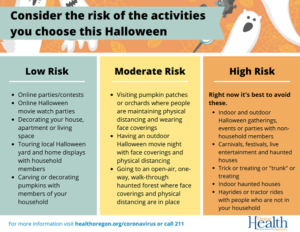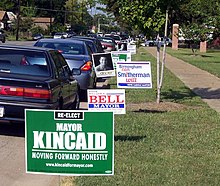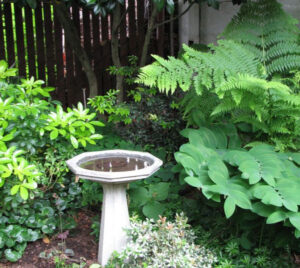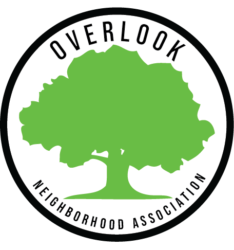4) Free yard and garden workshops
1) OKNA Board meeting
The Overlook Neighborhood Association board will meet Tuesday, Oct. 6 at 6:30 p.m. The meeting will be held via Zoom.
This will be the first meeting of the new board selected in September. The board will select executives, approve committee chairs, discuss the upcoming issue of Overlook Views and more. View the full agenda.
Neighbors and others are welcome to join the call and observe the meeting. A recording will be posted to our YouTube channel.
2) Halloween vs. coronavirus
 With Halloween right around the corner, families might be wondering how safe it is to let kids wander door to door. Choosing low risk Halloween plans can help to prevent the spread of COVID-19, decrease the impact on Oregon’s health care system and save lives.
With Halloween right around the corner, families might be wondering how safe it is to let kids wander door to door. Choosing low risk Halloween plans can help to prevent the spread of COVID-19, decrease the impact on Oregon’s health care system and save lives.
 The Oregon Health Authority recommends that Oregonians avoid traditional door-to-door trick or treating and “Trunk or Treat” events because these are high risk activities for crowding among people outside your household. This recommendation aligns with the Centers for Disease Control (CDC), which also recommends families avoid traditional trick or treating.
The Oregon Health Authority recommends that Oregonians avoid traditional door-to-door trick or treating and “Trunk or Treat” events because these are high risk activities for crowding among people outside your household. This recommendation aligns with the Centers for Disease Control (CDC), which also recommends families avoid traditional trick or treating.
Some ideas for safer, low-risk activities include holding an online costume contest, watching a scary movie online, carving pumpkins with people in your household, decorating your house or apartment, or touring the neighborhood to look at decorated houses with members of your household.
3) Campaign sign rules
Election season is here, and many people are excited to support their preferred candidates with campaign signs. Please remember to follow local and state rules about placing signs, political or otherwise.
 The easiest thing to do to ensure compliance is keep standard-sized campaign signs on your own property. There is no limit on the number of lawn signs, but each must be no larger than 3 square feet. Signs may not be illuminated.
The easiest thing to do to ensure compliance is keep standard-sized campaign signs on your own property. There is no limit on the number of lawn signs, but each must be no larger than 3 square feet. Signs may not be illuminated.
Signs are not allowed in state and local rights of way or on public property like schools. Traffic islands, sidewalks, street medians, planting strips and similar areas are off limits. So are poles. Signs that violate those rules could be removed.
The City of Portland auditor has more details about where signs are allowed and how big they may be.
If you live near an Oregon Department of Transportation right of way, additional rules could apply.
Finally, please remove campaign signs after the election and dispose of them appropriately.
4) Free yard and garden workshops
 East Multnomah Soil and Water Conservation District has launched its annual free fall workshop series. Now is the perfect time to learn how to create your own attractive, low-maintenance landscape.
East Multnomah Soil and Water Conservation District has launched its annual free fall workshop series. Now is the perfect time to learn how to create your own attractive, low-maintenance landscape.
Attend an online workshop to discover simple gardening practices that will help you create a beautiful landscape that conserves water, reduces pollution and attracts beneficial wildlife to your yard. These classes are great for all levels of gardening enthusiasts. Topics include attracting pollinators, native plants, and creating an edible landscape.
View a full list of classes and register online.
5) Fireproof your yard
This year’s devastating fires in Oregon and throughout the West have demonstrated just how vulnerable communities are to wildfire. Fire isn’t just a problem in rural areas, either. Forested urban areas are at risk, too.
 That’s especially true in wooded parts of the Overlook Neighborhood along the bluff and the N Going Street cut. In fact, most of those areas are designated as wildfire hazard zones. Already this summer several fires have occurred at homeless camps in Madrona Park and other parts of the neighborhood. We’ve been fortunate that the Fire Department responded quickly.
That’s especially true in wooded parts of the Overlook Neighborhood along the bluff and the N Going Street cut. In fact, most of those areas are designated as wildfire hazard zones. Already this summer several fires have occurred at homeless camps in Madrona Park and other parts of the neighborhood. We’ve been fortunate that the Fire Department responded quickly.
The North Portland bluff has a history of fire, too. Fires got out of control in 2001 and 2011.
Recent rain and cooler weather have mitigated the risk some, but a few warm, dry days could elevate the danger level again. In the worst-case scenario, a fire that begins along the bluff could quickly spread to nearby homes.
In high-risk areas like Overlook, the most important action a homeowner can take is to create a wildfire resistant landscape through proper plant placement, plant spacing and ongoing plant maintenance. Steps that homeowners can take include:
- Space groupings of plants so that at their expected mature height, the crowns of the groupings provide at least 10 feet of clear space from each other and from structures. This will prevent fire from spreading across planting groups.
- If possible, create a 30-foot perimeter around your home free of combustible materials. That includes firewood stacks.
- Prune back tree branches within 10 feet of walls and roofs.
- Trim limbs of coniferous trees within 30 feet of structures so that none of the limbs are closer than 6 feet from the ground. This reduces the chances that a ground fire can “ladder” up into the tree.
- Water vegetation, including the lawn, to keep moisture levels high and reduce fuel.
- Keep grass trimmed to less than four inches.
- Rake ground covers such as bark mulch, wood chips, compost and tree litter away from flammable structural components of your home (decks, siding). Even though ground covers generally only smolder, homes can be damaged by a creeping fire which can ignite structural components.
- Remove invasive, nuisance plants or prohibited plants from your landscape because they can be highly flammable and can serve as “ladder” fuels. This includes European hawthorn, Himalayan blackberry, Scot’s broom, English holly and English ivy.
Residents also should prepare for an emergency by developing a family evacuation plan and preparing a small “grab and go” kit.
For more tips about what you can do to help prevent a wildfire from damaging your home, check out this helpful document from the city’s planning department.
